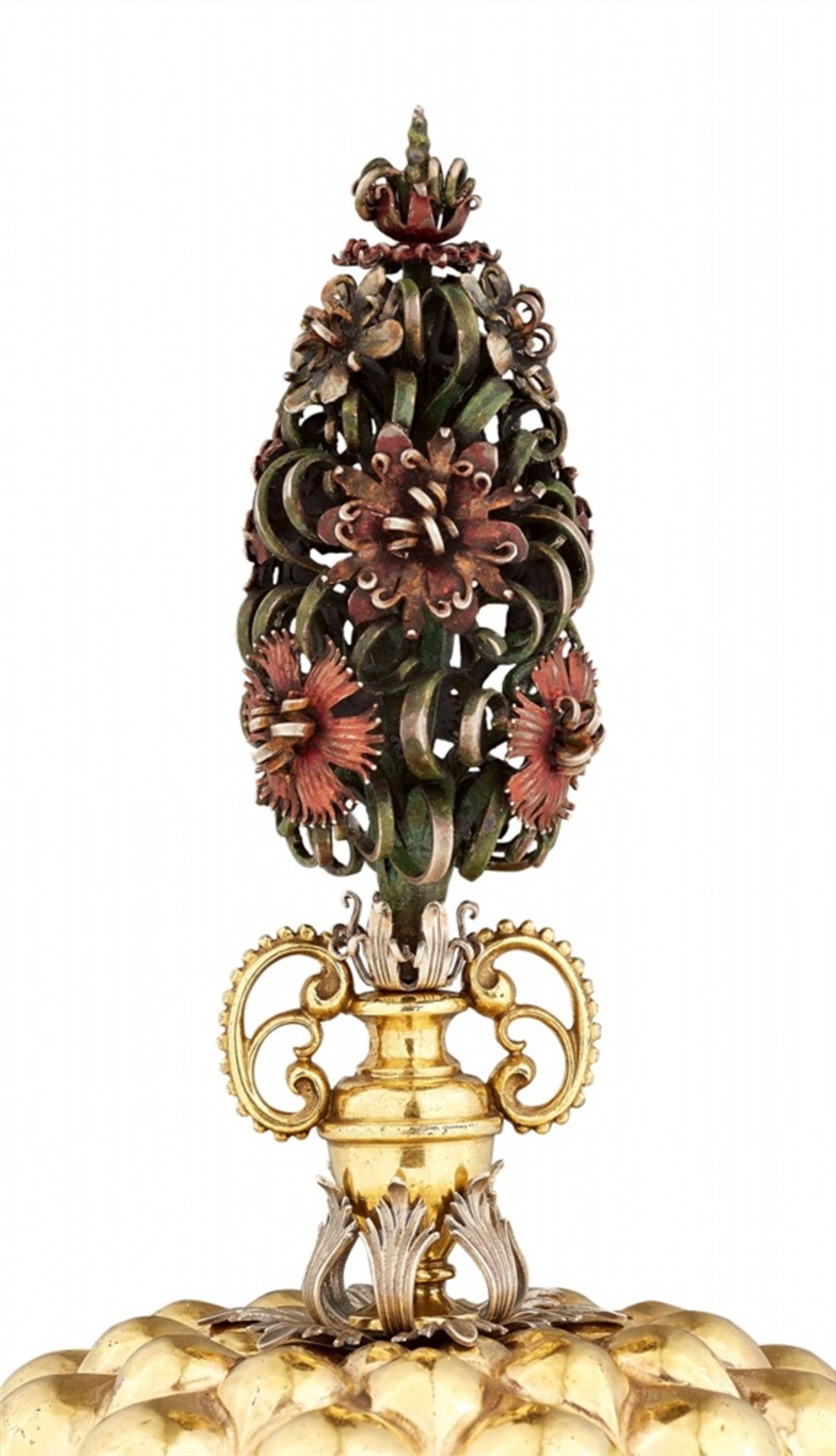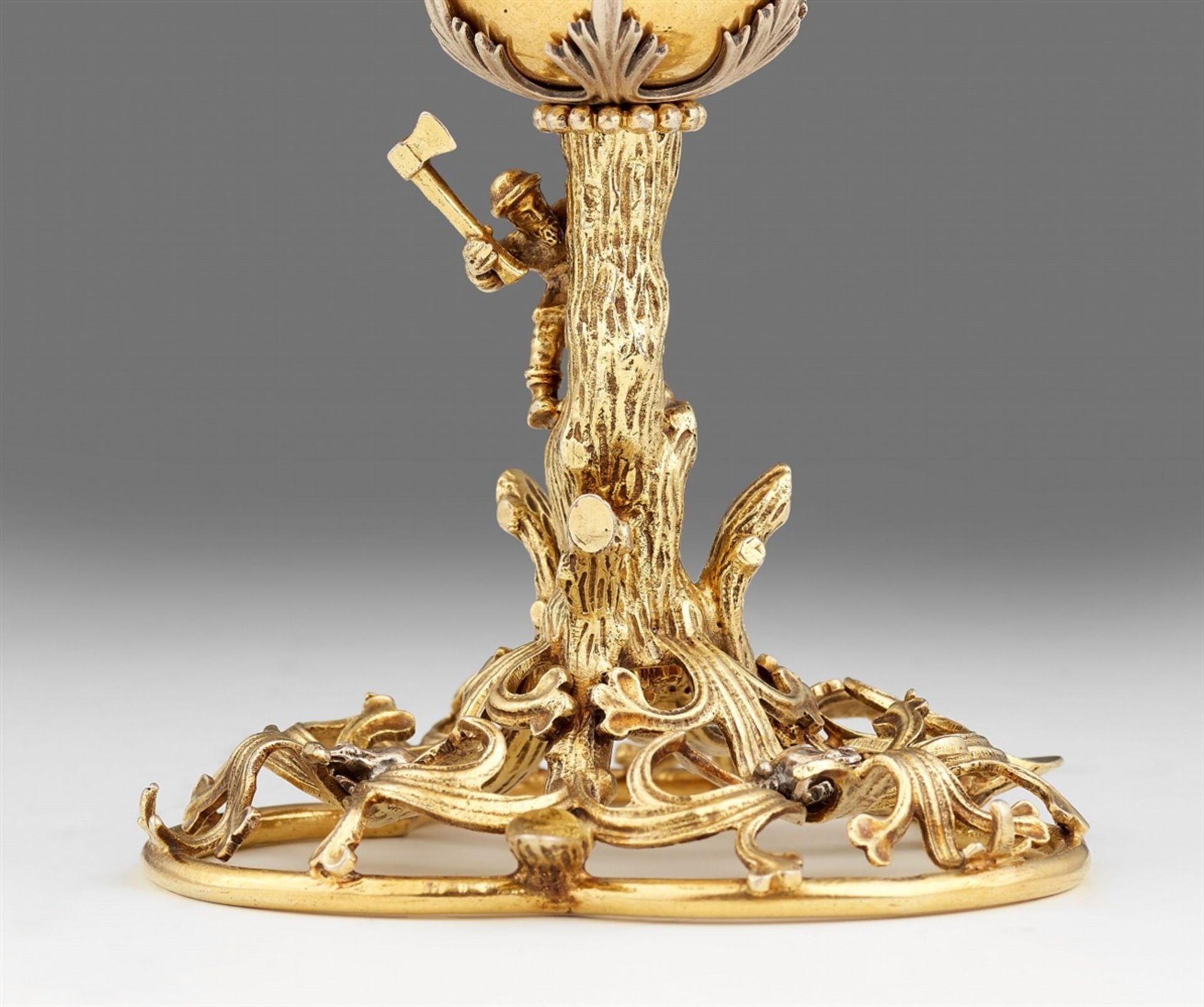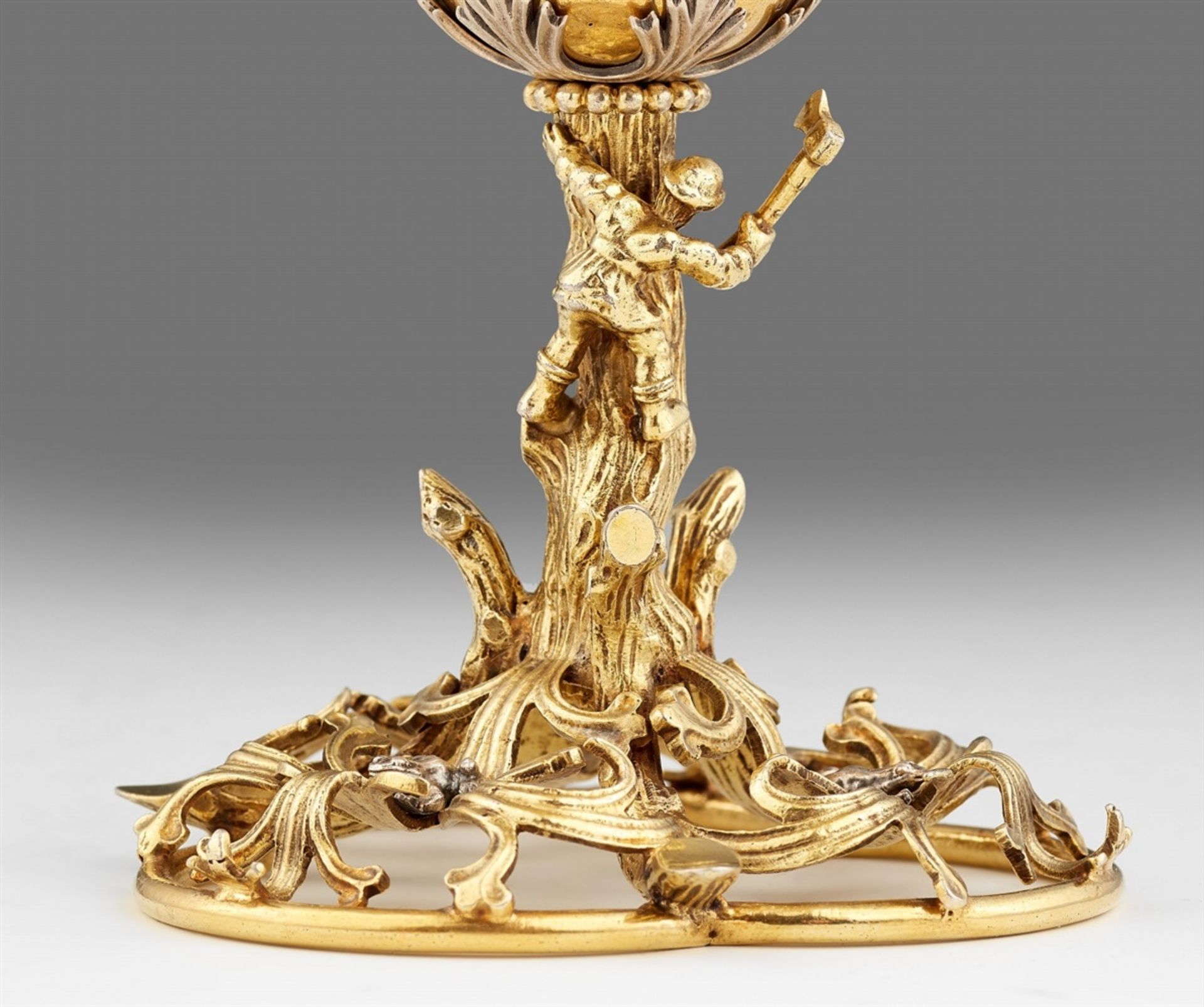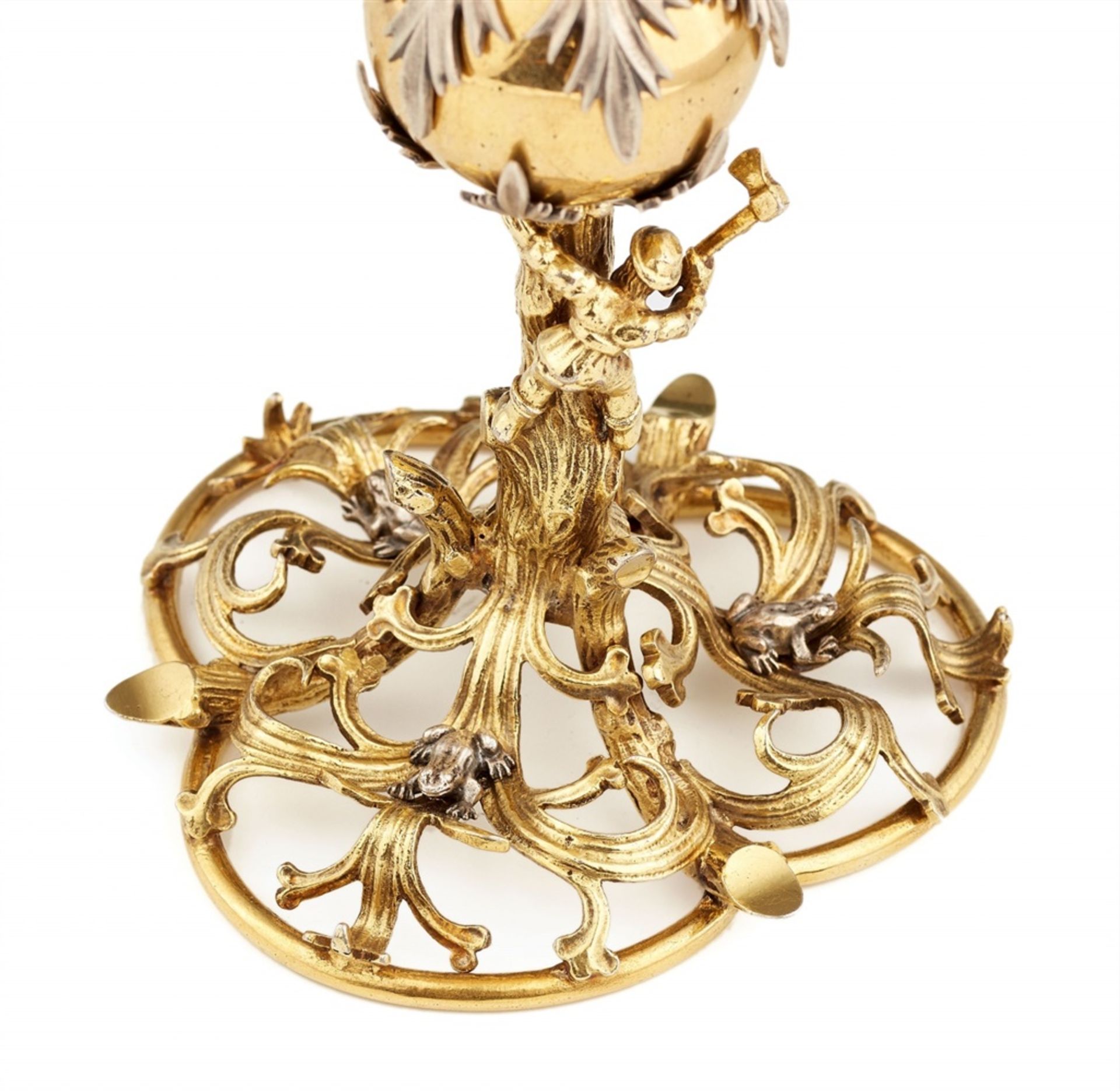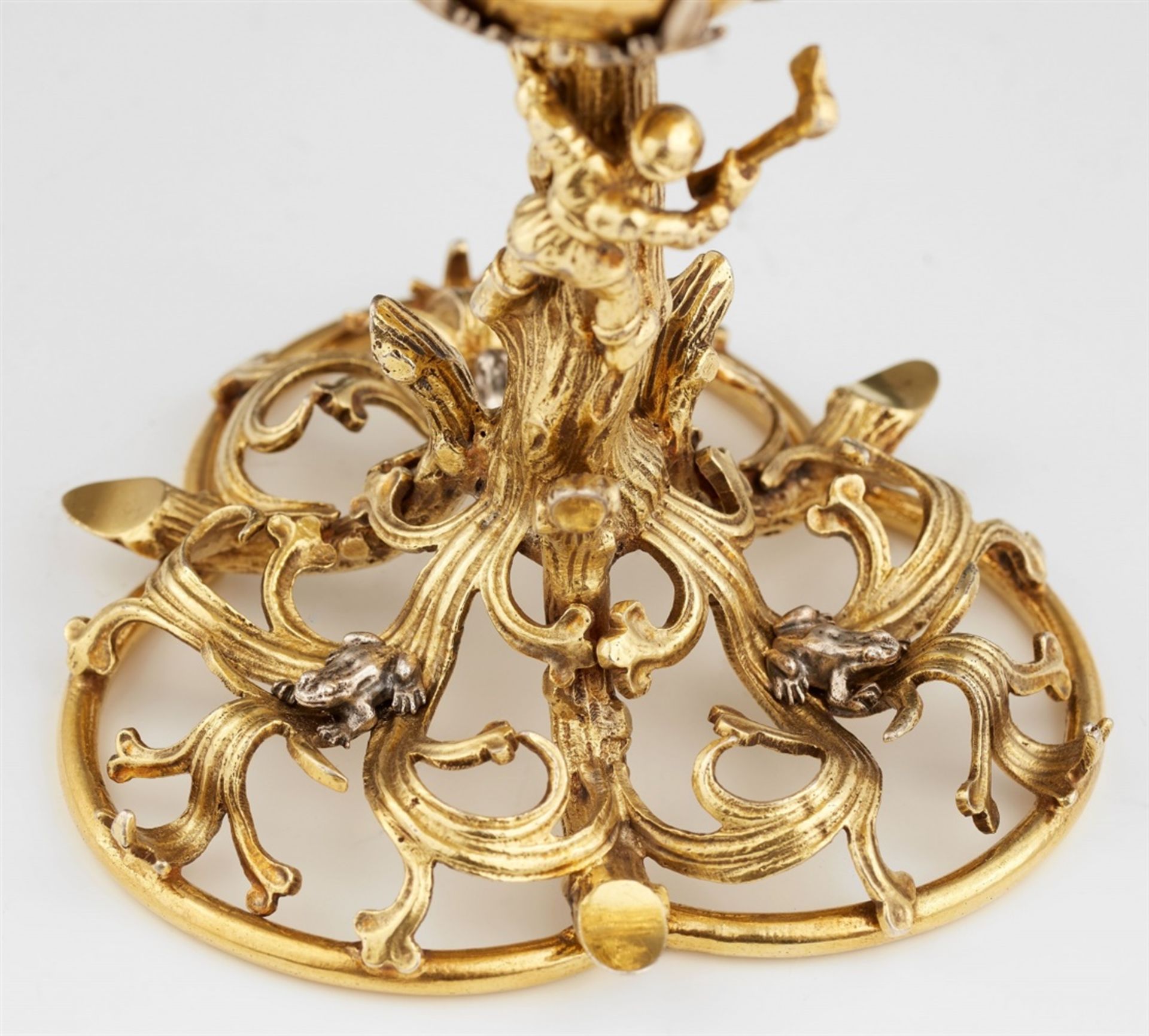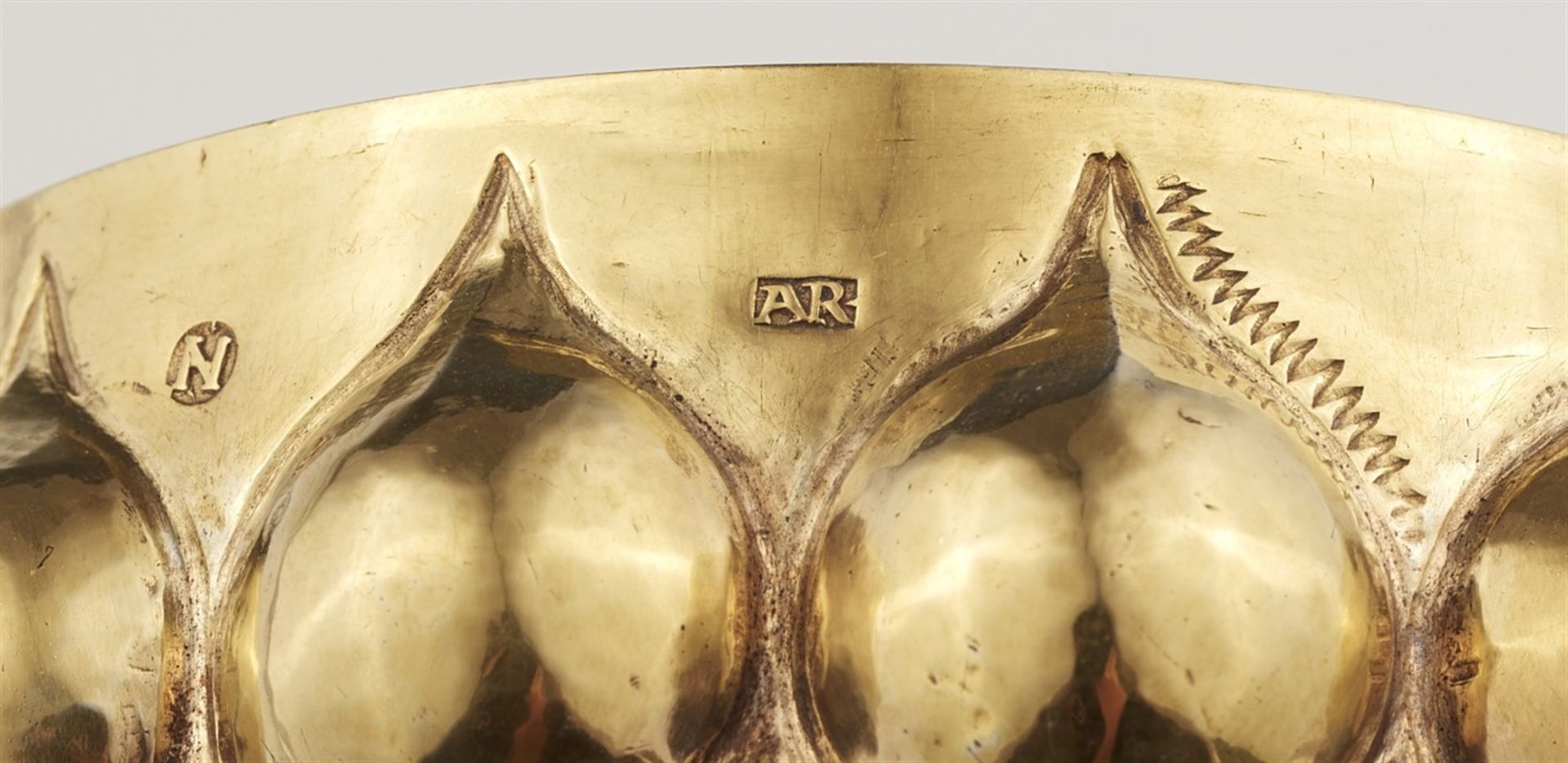703
An important Renaissance polychromed silver gobletSilber; vergoldet. Silver-gilt cup on a pierced
Bedeutender Renaissance-Pokal mit Farbfassung
Silber; vergoldet. Dreipassiger, àjour gearbeiteter Fuß mit ziselierten Rebenästen und drei aufgesetzten, naturalistisch wiedergegebenen Fröschen. Der Stamm in Form eines Weinstocks mit detailliert ausgeführtem Holzfäller mit Axt. Über einem kugelförmigen Zwischenglied mit Zierblattwerk die große Kuppa mit getriebenen Traubenbuckeln in versetzten Reihen. Der aufgewölbte Deckel entsprechend; als Bekrönung eine Vase mit polychrom gefasstem Schmeck. Marken: BZ Nürnberg, MZ Andreas Roßner (auch: Rößner, 1592/93 - 1601, GNM Nr. 753), Tremolierstich. H 32,9 cm, Gewicht: 402 g.
Nürnberg, Andreas Roßner, 1592 - 1601.
Die in der Literatur seit dem 19. Jahrhundert verbreitete Bezeichnung "Kaltemail" ist im Grunde irreführend, da sie eine spezielle Emailtechnik suggeriert. Die partielle Polychromie, die sich auf den Schmecks und Silberobjekten einiger Objekte, beispielsweise des Grünen Gewölbes oder der Kunstkammer des Historischen Museums in Wien, erhalten hat, ist aber nicht auf die Aufschmelzung von Emailfarben zurückzuführen, sondern auf ein maltechnisches Verfahren, bei dem ein Pigment oder ein verlackter Farbstoff in einem geeigneten Bindemittel auf die fertig bearbeitete Metalloberfläche aufgetragen wird. Weinhold/Witting haben daher den Terminus "Farbfassung" auch für Silberobjekte vorgeschlagen (vgl. op. cit., S. 16 ff.)
Diese Farbfassungen weisen naturgemäß eine geringere Haltbarkeit auf als ein aufgeschmolzenes Email, so dass Objekte mit erhaltener Polychromie heute in öffentlichen und privaten Sammlungen von großer Seltenheit sind.
Ein zweites Merkmal, das unseren Pokal bemerkenswert macht, ist der filigrane, àjour gearbeitete Fuß, der bei den wenigsten Pokalen des 16. und 17. Jahrhunderts anzutreffen ist. So findet sich im Bildband des Standardwerks des Germanischen Nationalmuseums von 2007 kein einziges Beispiel. Selbst international sind in den Museen nur wenige Vergleichsstücke bekannt, darunter eines mit nahezu identischem Fuß in der Sammlung des Louvre in Paris (Inventar-Nr. OA 628).
Literatur
Die einzige, bislang nachweisbare Arbeit Roßners war eine Eule als Trinkgefäß in einer privaten Sammlung, die 1968 im Centennial Museum in Vancouver ausgestellt war; vgl. hierzu Kat. GNM, Nr. 753/01. Zu Farbfassungen auf Silberobjekten vgl. Weinhold/Witting, Farbfassungen auf Goldschmiedearbeiten des 16. bis 18. Jahrhunderts am Dresdner Hof, Dresden 2018, hier vor allem zwei Nürnberger Traubenpokale Hans Beutmüllers, Abb. 5. Zu Nürnberger Vergleichsstücken mit àjour gearbeitetem Fuß vgl. u. a. Kat. GNM 2007, Nr. 640.05, sowie Kat. Chefs-d'oeuvre d'orfèvrerie allemande, Paris 2017, Nr. 21.
An important Renaissance polychromed silver goblet
Silber; vergoldet. Silver-gilt cup on a pierced trefoil base with chased vine sprigs and three naturalistically rendered frog appliques. The stem formed as a detailed figure of a wood cutter beside a grape vine supporting a spherical connecting motif and the large cuppa formed as a stylised bunch of grapes, the corresponding lid with a polychrome scroll finial. Brands: BZ Nuremberg, MZ Andreas Roßner (also: Rößner, 1592/93 - 1601, GNM No. 753), tremolier stitch. H 32.9 cm, weight 402 g.
Marks of Andreas Roßner, 1592 – 1601.
The term “kaltemail” or “cold enamel” has been used in academic literature since the 19th century, but it is somewhat misleading since it suggests that this is an enamelling technique. The type of polychromy used on the finial of this piece and on several other items of silverware, for example works in the Grünes Gewölbe in Dresden or the Kunstkammer of the Historisches Museum in Vienna, is not in fact enamel, which must be melted, but a painting technique in which a pigment or lacquer is simply mixed with a suitable medium and painted on to the finished metalwork. For this reason, Weinhold/Witting have suggested the use of the term “polychromy” for this technique when found on silverware (cf. ibid., p. 16 ff.)
As might be expected, this kind of polychrome décor displays a much lower adhesion than a melted enamel glaze, thus it is extremely rare to find items with this kind of décor in public or private collections today. A second feature that makes this particular goblet unique is the delicately pierced base, which is rarely encountered on chalices of the 16th or 17th centuries. The standard work of the Germanisches Nationalmuseum from 2007 does not list a single example. Even in international museums there are few comparable pieces to be found, although one work with an almost identical base can be found in the Louvre in Paris (inv. no. OA 628).
Literature
Thus far, the only other known work by Roßner is a drinking vessel in the form of an owl in a private collection, which was exhibited in 1968 in the Centennial Museum in Vancouver, cf. cat.: GNM, no. 753/01. For more on polychromed metalwork, cf.: Weinhold/Witting, Farbfassungen auf Goldschmiedearbeiten des 16. bis 18. Jahrhunderts am Dresdner Hof, Dresden 2018, especially relevant here is a Nuremberg silver chalice by Hans Beutmüller, illus. 5. For comparable Nuremberg works with pierced bases, cf.: GNM 2007, no. 640.05, and cat.: Chefs-d'oeuvre d'orfèvrerie allemande, Paris 2017, no. 21.
Bedeutender Renaissance-Pokal mit Farbfassung
Silber; vergoldet. Dreipassiger, àjour gearbeiteter Fuß mit ziselierten Rebenästen und drei aufgesetzten, naturalistisch wiedergegebenen Fröschen. Der Stamm in Form eines Weinstocks mit detailliert ausgeführtem Holzfäller mit Axt. Über einem kugelförmigen Zwischenglied mit Zierblattwerk die große Kuppa mit getriebenen Traubenbuckeln in versetzten Reihen. Der aufgewölbte Deckel entsprechend; als Bekrönung eine Vase mit polychrom gefasstem Schmeck. Marken: BZ Nürnberg, MZ Andreas Roßner (auch: Rößner, 1592/93 - 1601, GNM Nr. 753), Tremolierstich. H 32,9 cm, Gewicht: 402 g.
Nürnberg, Andreas Roßner, 1592 - 1601.
Die in der Literatur seit dem 19. Jahrhundert verbreitete Bezeichnung "Kaltemail" ist im Grunde irreführend, da sie eine spezielle Emailtechnik suggeriert. Die partielle Polychromie, die sich auf den Schmecks und Silberobjekten einiger Objekte, beispielsweise des Grünen Gewölbes oder der Kunstkammer des Historischen Museums in Wien, erhalten hat, ist aber nicht auf die Aufschmelzung von Emailfarben zurückzuführen, sondern auf ein maltechnisches Verfahren, bei dem ein Pigment oder ein verlackter Farbstoff in einem geeigneten Bindemittel auf die fertig bearbeitete Metalloberfläche aufgetragen wird. Weinhold/Witting haben daher den Terminus "Farbfassung" auch für Silberobjekte vorgeschlagen (vgl. op. cit., S. 16 ff.)
Diese Farbfassungen weisen naturgemäß eine geringere Haltbarkeit auf als ein aufgeschmolzenes Email, so dass Objekte mit erhaltener Polychromie heute in öffentlichen und privaten Sammlungen von großer Seltenheit sind.
Ein zweites Merkmal, das unseren Pokal bemerkenswert macht, ist der filigrane, àjour gearbeitete Fuß, der bei den wenigsten Pokalen des 16. und 17. Jahrhunderts anzutreffen ist. So findet sich im Bildband des Standardwerks des Germanischen Nationalmuseums von 2007 kein einziges Beispiel. Selbst international sind in den Museen nur wenige Vergleichsstücke bekannt, darunter eines mit nahezu identischem Fuß in der Sammlung des Louvre in Paris (Inventar-Nr. OA 628).
Literatur
Die einzige, bislang nachweisbare Arbeit Roßners war eine Eule als Trinkgefäß in einer privaten Sammlung, die 1968 im Centennial Museum in Vancouver ausgestellt war; vgl. hierzu Kat. GNM, Nr. 753/01. Zu Farbfassungen auf Silberobjekten vgl. Weinhold/Witting, Farbfassungen auf Goldschmiedearbeiten des 16. bis 18. Jahrhunderts am Dresdner Hof, Dresden 2018, hier vor allem zwei Nürnberger Traubenpokale Hans Beutmüllers, Abb. 5. Zu Nürnberger Vergleichsstücken mit àjour gearbeitetem Fuß vgl. u. a. Kat. GNM 2007, Nr. 640.05, sowie Kat. Chefs-d'oeuvre d'orfèvrerie allemande, Paris 2017, Nr. 21.
An important Renaissance polychromed silver goblet
Silber; vergoldet. Silver-gilt cup on a pierced trefoil base with chased vine sprigs and three naturalistically rendered frog appliques. The stem formed as a detailed figure of a wood cutter beside a grape vine supporting a spherical connecting motif and the large cuppa formed as a stylised bunch of grapes, the corresponding lid with a polychrome scroll finial. Brands: BZ Nuremberg, MZ Andreas Roßner (also: Rößner, 1592/93 - 1601, GNM No. 753), tremolier stitch. H 32.9 cm, weight 402 g.
Marks of Andreas Roßner, 1592 – 1601.
The term “kaltemail” or “cold enamel” has been used in academic literature since the 19th century, but it is somewhat misleading since it suggests that this is an enamelling technique. The type of polychromy used on the finial of this piece and on several other items of silverware, for example works in the Grünes Gewölbe in Dresden or the Kunstkammer of the Historisches Museum in Vienna, is not in fact enamel, which must be melted, but a painting technique in which a pigment or lacquer is simply mixed with a suitable medium and painted on to the finished metalwork. For this reason, Weinhold/Witting have suggested the use of the term “polychromy” for this technique when found on silverware (cf. ibid., p. 16 ff.)
As might be expected, this kind of polychrome décor displays a much lower adhesion than a melted enamel glaze, thus it is extremely rare to find items with this kind of décor in public or private collections today. A second feature that makes this particular goblet unique is the delicately pierced base, which is rarely encountered on chalices of the 16th or 17th centuries. The standard work of the Germanisches Nationalmuseum from 2007 does not list a single example. Even in international museums there are few comparable pieces to be found, although one work with an almost identical base can be found in the Louvre in Paris (inv. no. OA 628).
Literature
Thus far, the only other known work by Roßner is a drinking vessel in the form of an owl in a private collection, which was exhibited in 1968 in the Centennial Museum in Vancouver, cf. cat.: GNM, no. 753/01. For more on polychromed metalwork, cf.: Weinhold/Witting, Farbfassungen auf Goldschmiedearbeiten des 16. bis 18. Jahrhunderts am Dresdner Hof, Dresden 2018, especially relevant here is a Nuremberg silver chalice by Hans Beutmüller, illus. 5. For comparable Nuremberg works with pierced bases, cf.: GNM 2007, no. 640.05, and cat.: Chefs-d'oeuvre d'orfèvrerie allemande, Paris 2017, no. 21.
Decorative Kunst
Auktionsdatum
Ort der Versteigerung
Für Kunsthaus Lempertz Versandinformtation bitte wählen Sie +49 (0)221 9257290.
Wichtige Informationen
Nothing important.
AGB
standard | standard
Conditions of Sale
1. The art auction house, Kunsthaus Lempertz KG (henceforth referred to as Lempertz), conducts public auctions in terms of § 383 paragraph 3 sentence 1 of the Civil Code as commissioning agent on behalf of the accounts of submitters, who remain anonymous. With regard to its auctioneering terms and conditions drawn up in other languages, the German version remains the official one.
2. The auctioneer reserves the right to divide or combine any catalogue lots or, if it has special reason to do so, to offer any lot for sale in an order different from that given in the catalogue or to withdraw any lot from the sale.
3. All lots put up for sale may be viewed and inspected prior to the auction. The catalogue specifications and related specifications appearing on the internet, which have both been compiled in good conscience, do not form part of the contractually agreed to conditions. These specifications have been derived from the status of the information available at the time of compiling the catalogue. They do not serve as a guarantee in legal terms and their purpose is purely in the information they provide. The same applies to any reports on an item’s condition or any other information, either in oral or written form. Certificates or certifications from artists, their estates or experts relevant to each case only form a contractual part of the agreement if they are specifically mentioned in the catalogue text. The state of the item is generally not mentioned in the catalogue. Likewise missing specifications do not constitute an agreement on quality. All items are used goods.
4. Warranty claims are excluded. In the event of variances from the catalogue descriptions, which result in negation or substantial diminution of value or suitability, and which are reported with due justification within one year after handover, Lempertz nevertheless undertakes to pursue its rights against the seller through the courts; in the event of a successful claim against the seller, Lempertz will reimburse the buyer only the total purchase price paid. Over and above this, Lempertz undertakes to reimburse its commission within a given period of three years after the date of the sale if the object in question proves not to be authentic.
5. Claims for compensation as the result of a fault or defect in the object auctioned or damage to it or its loss, regardless of the legal grounds, or as the result of variances from the catalogue description or statements made elsewhere are excluded unless Lempertz acted with wilful intent or gross negligence; the liability for bodily injury or damages caused to health or life remains unaffected. In other regards, point 4 applies.
6. Submission of bids. Bids in attendance: The floor bidder receives a bidding number on presentation of a photo ID. Lempertz reserves the right to grant entry to the auction. If the bidder is not known to Lempertz, registration must take place 24 hours before the auction is due to begin in writing on presentation of a current bank reference. Bids in absentia: Bids can also be submitted either in writing, telephonically or via the internet. The placing of bids in absentia must reach Lempertz 24 hours before the auction to ensure the proper processing thereof. The item must be mentioned in the bid placed, together with the lot number and item description. In the event of ambiguities, the listed lot number becomes applicable. The placement of a bid must be signed by the applicant. The regulations regarding revocations and the right to return the goods in the case of long distance agreements (§ 312b-d of the Civil Code) do not apply. Telephone bids: Establishing and maintaining a connection cannot be vouched for. In submitting a bid placement, the bidder declares that he agrees to the recording of the bidding process. Bids via the internet: They will only be accepted by Lempertz if the bidder registered himself on the internet website beforehand. Lempertz will treat such bids in the same way as bids in writing.
7. Carrying out the auction: The hammer will come down when no higher bids are submitted after three calls for a bid. In extenuating circumstances, the auctioneer reserves the right to bring down the hammer or he can refuse to accept a bid. If several individuals make the same bid at the same time, and after the third call, no higher bid ensues, then the ticket becomes the deciding factor. The auctioneer can retract his acceptance of the bid and auction the item once more if a higher bid that was submitted on time, was erroneously overlooked and immediately queried by the bidder, or if any doubts regarding its acceptance arise. Written bids are only played to an absolute maximum by Lempertz if this is deemed necessary to outbid
another bid. The auctioneer can bid on behalf of the submitter up to the agreed limit, without revealing this and irrespective of whether other bids are submitted. Even if bids have been placed and the hammer has not come down, the auctioneer is only liable to the bidder in the event of premeditation or gross negligence.
8. Once a lot has been knocked down, the successful bidder is obliged to buy it. If a bid is accepted conditionally, the bidder is bound by his bid until four weeks after the auction unless he immediately withdraws from the conditionally accepted bid. From the fall of the hammer, possession and risk pass directly to the buyer, while ownership passes to the buyer only after full payment has been received.
9. Up to a hammer price of € 400,000 a premium of 24 % calculated on the hammer price plus 19 % value added tax (VAT) calculated on the premium only is levied. The premium will be reduced to 20 % (plus VAT) on any amount surpassing € 400,000 (margin scheme). On lots which are characterized by N, an additional 7 % for import tax will be charged. On lots which are characterized by an D, 35% is calculated on the hammer price (24% buyer´s premium + 19% VAT on the premium only + import tax). 31% is calculated on the amount surpassing € 400.000. The D objects contain all taxes, and tehy can not be carried away immediately. On lots which are characterized by an R, the buyer shall pay a premium of 24 % on the hammer price up to € 400,000 and 20 % on the surpassing amount; onto this (hammer price and premium) the statutory VAT of 19 % will be added (regular scheme). Exports to third (i.e. non-EU) countries will be exempt from VAT, and so will be exports made by companies from other EU member states if they state their VAT identification number. For original works of art, whose authors are either still alive or died after 31.12.1948, a charge of 1.8 % on the hammer price will be levied for the droit de suite. The maximum charge is € 12,500. If a buyer exports an object to a third country personally, the VAT will be refunded, as soon as Lempertz receives the export and import papers. All invoices issued on the day of auction or soon after remain under provision.
10. Successful bidders attending the auction in person shall forthwith upon the purchase pay to Lempertz the final price (hammer price plus premium and VAT) in Euro. Payments by foreign buyers who have bid in writing or by proxy shall also be due forthwith upon the purchase, but will not be deemed to have been delayed if received within ten days of the invoice date. Bank transfers are to be exclusively in Euros. The request for an alteration of an auction invoice to a person other than the bidder has to be made immediately after the auction. Lempertz however reserves the right to refuse such a request if it is deemed appropriate.
11. In the case of payment default, Lempertz will charge 1% interest on the outstanding amount of the gross price per month.. If the buyer defaults in payment, Lempertz may at its discretion insist on performance of the purchase contract or, after allowing a period of grace, claim damages for non-performance. In the latter case, Lempertz may determine the amount of the damages by putting the lot or lots up for auction again, in which case the defaulting buyer will bear the amount of any reduction in the proceeds compared with the earlier auction, plus the cost of resale, including the premium.
12. Buyers must take charge of their purchases immediately after the auction. Once a lot has been sold, the auctioneer is liable only for wilful intent or gross negligence. Lots will not, however, be surrendered to buyers until full payment has been received. Without exception, shipment will be at the expense and risk of the buyer. Purchases which are not collected within four weeks after the auction may be stored and insured by Lempertz on behalf of the buyer and at its expense in the premises of a freight agent. If Lempertz stores such items itself, it will charge 1 % of the hammer price for insurance and storage costs.
13. As far as this can be agreed, the place of performance and jurisdiction is Cologne. German law applies; the German law for the protection of cultural goods applies; the provisions of the United Nations Convention on Contracts for the International Sale of Goods (CISG) are not applicable. Should any provision herein be wholly or partially ineffective, this will not affect the validity of the remaining provisions.
Henrik Hanstein, sworn public auctioneer
Takuro Ito, Kilian Jay von Seldeneck, auctioneers

















